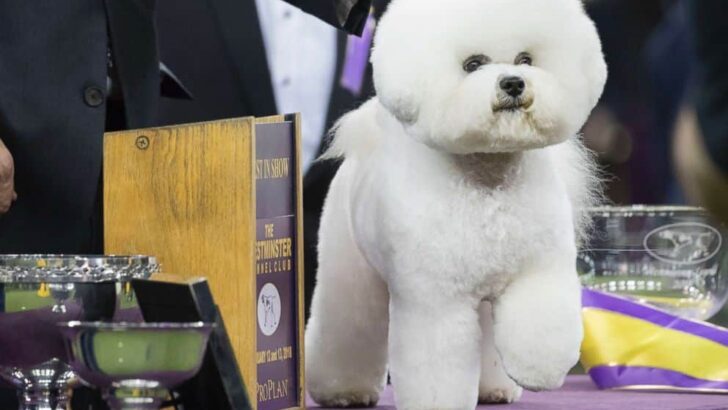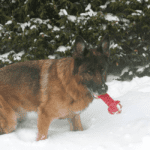- How to Figure Out Your Dog’s Age - January 8, 2022
- Prescription Diet Dog Food Guide and Recommendations - December 12, 2019
- How To Take Care of Your Bichon Frise (Grooming Tips) - December 12, 2019
I have to admit. When I heard this year’s winner of the Best in Show was Flynn, the adorable Bichon Frise, I picked up my little Harley, cheered, and kissed her while we did a little dance.
Flynn’s magnificent circular groomed head, neatly trimmed body, and strutting steps was the picture of Bichon perfection. He looked like my little Harley when her hair is long, clean, and fresh from the spa. Flynn was the second Bichon Frise to win Best in Show since the 2001 Westminster dog show.
Westminster Kennel Club
Named after the Westminster Hotel, the group of sporting enthusiasts met to share tips, pointers, and adventures about their canines; the Westminster Breeding Association was created sometime around 1876. These men loved to share tips on how to “raise Pointers for hunting and field trials”. That same year, to celebrate America’s centennial, the association helped structure a dog show held in Philadelphia.
After the show’s success, the association officially changed their name to Westminster Kennel Club (WKC). In 1877 they incorporated the name and the club held The First Annual New York Bench Show of Dogs.
“Benched” refers to those competing dogs required to remain at their assigned bench for the entire competition as breeders and spectators are educated on each breed.
As the association started to grow, in 1884 the Westminster Kennel Club and the Philadelphia Kennel Club met and established the American Kennel Club (AKC). The AKC became the national governing body for dog registration and dog shows.

In 1905, Westminster becomes the largest dog show in history. It exhibited over 1,752 dogs. Two years later, the first Best in Show award was presented for the first time at Westminster and in 1924, The Westminster Kennel Club became the first club to oversee Best in Show. They judged the competition in accordance with the new rules and format enforced by the AKC. The Best in Show competition included five group winners: Sporting, Working, Terrier, Toy, and Non-Sporting.
In 1948, coverage of the Westminster Best in Show was shown on television and in 2005 breed judging was broadcasted to the general public via streaming video on WKC’s website. This became the beginning of the show’s popularity which increased the following year and continues to grow in popularity today.
Road to Westminster
Thousands of dog breeders, handlers, and owners enter their babies to Westminster in hopes their babies are recognized as the Best in Show. However, the road to Westminster is along and tedious process that requires countless hours of training and grooming. Canines and their handlers travel to compete to earn top rankings, champions, and qualifications to advance with the “best”.
The road to Westminster begins with the competition of AKC registered purebreds. Handlers train their canines to earn 15 points and two major wins to become an American Kennel Club “Champion of Record”. Once your dog has earned status via several championships, they may enter Westminster competitions.
Competitors must complete and win the following championships:
- Breeder Series: Kent Boyles, Wisconsin
- Atlanta Kennel Club Dog Show, Atlanta, GA
- Ladies Kennel Association of America, Oyster Bay, NY
- World Series of Dog Shows, Houston, TX
- Breeder Series: Bill Shelton, Pomona, CA
- Santa Barbara Kennel Club Dog Show, Santa Barbara, CA
Classes & Categories
Dogs compete by gender in their respective breeds. They are entered into three classes:
- Bred by Exhibitor
- American-Bred
- Open
Under each class, dogs are then awarded according to three classifications:
- Best of Breed: Dogs are “judged as the best in its breed category.”
- Best of Winners: Dogs are “judged as the better of the Winners Dog and Winners Bitch.”
- Best of Opposite Sex: “The best dog that is the opposite sex to the Best of Breed winner.”
Only the winners of the Best of Breed advance to compete in the classified groups they belong to.
Breeds & Varieties
“A variety is a division of a breed based on coat, color or size. Each variety competes separately in the Group.” The first level of competition at Westminster starts with the Breeds/Variety competition.
Per the Westminster Kennel Club website, the breeds below compete in the varieties below:
COLOR
- Cocker Spaniels (3): Black, ASCOB, Parti Color
- Bull Terriers (2): Colored, White
- English Toy Spaniels (2): Blenheim & Prince Charles, King Charles & Ruby
COAT
- Dachshunds (3): Longhaired, Smooth, Wirehaired
- Chihuahuas (2): Long Coat, Smooth
- Collie (2): Rough, Smooth
SIZE
- Beagles (2): Not exceeding 13”, Over 13” But Not Exceeding 15”
- Manchester Terriers (2): Standard, Toy
- Poodles (3): Miniature, Standard, Toy
Classification Groups
SPORTING: Bred to assist hunters, sporting dogs are extremely energetic with solid temperaments.

As defined by the WKC, “Pointers and Setters point and mark the game, Spaniels flush the bird, Retrievers recover the game from land or water.”
HOUND: Hunters by trait, hounds are trained to catch the game themselves or keep it until it’s owner arrives. They can also track by scent.
- Sight Hounds: Use their eyes to hunt.
- Scent Hounds: Use their extraordinary olfactory senses to track.
WORKING: Working dogs have a strong and powerful build. They are also intelligent and are able to perform a plethora of trained tasks. These dogs usually work as police, military and service dogs.
TERRIER: “Determined and courageous,” Terriers are “small and agile” and were developed to “quarry” for rats, foxes, and other vermin.
TOY: These tiny dogs were bred to be companions. Toys are happy, “full of life and spirit.”
NON-SPORTING: These dogs come with “a great diversity of traits not fitting any of the above.”

HERDING: Herding dogs are born with a natural herding instinct to move livestock around. They are found in ranches and farms helping with the herd of sheep, goats, etc.
Judging & Standards
“Each breed’s parent club creates a STANDARD, a written description of the ideal specimen of that breed.”
Standards are broken down to a breed’s “function” and characteristic. This means dogs are judged based on the action they were bred to perform and by their physical traits, such as:
- appearance;
- movement;
- temperament;
- height and weight;
- coat;
- colors;
- eye color and shape;
- ear shape and placement;
- feet; and
- tail.
However, standards are open to interpretation based on the written, maintained, and owned regulations of each breed’s parent clubs.
Awards & Recognitions
There is no monetary compensation awarded for the Best in Show. Bragging rights is the ultimate honor for the winner.
The Best in Show winner receives the following awards:
- Polished Pewter Gallery Bowl
- James Mortimer Memorial Sterling Silver Trophy
- Hand-engraved Steuben Crystal Bowl Westminster Legend Trophy
- Perpetual Sterling Silver Challenge Cup (American-Bred only)
- Polished Pewter Trophy
- 5? x 7? silver plated picture frame.
The Reserve Best in Show winner also receives a Polished Pewter Trophy for “Reserved Best in Show.”
Best in Breed/Variety & Miscellaneous Medallions
“The Westminster Kennel Club offers:
- Sterling silver medal for Best of Breed/Variety
- Antique brass medal for Best of Opposite Sex in each Breed/Variety
- Silver oxide medal for Select Dog and Select Bitch in each Breed/Variety and a bronze medal for Awards of Merit in each Breed/Variety
- Brass “New Champion” medal
- Copper New MACH and New PACH Medal
- Sterling Silver Obedience Finalist Medal and an Agility Championship 1st Place Medallion.
Regardless of breed, category or variety, all canines offer their own unique personality and characteristic. Westminster opens their door to spectators who love and honor dogs around the world. Watching handlers show off their babies is an enjoyable experience whether you tune in to watch it live on television or are fortunate enough to attend the event.
While I’m happy and proud that Flynn, the Bichon Frise, is representing Harley’s peeps, all doggies are winners in my book.
Continue reading:
The American Kennel Club (AKC) | How They Help
Mini Walrus Dog: Must-Know About The Sharpei Basset Hound (Bashar) Mix Puppy







